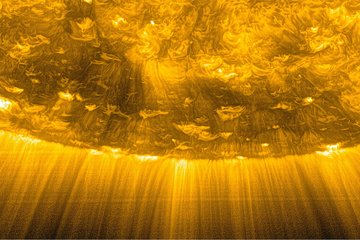All genres
1.
Journal Article
Determination of the lunar body tide from global laser altimetry data. Journal of Geodesy 95 (1), 4 (2021)
2.
Journal Article
Prospects for measuring Mercury’s tidal Love number h2 with the BepiColombo Laser Altimeter. Astronomy and Astrophysics 633, A85 (2020)
3.
Journal Article
Measuring Ganymede’s Librations with Laser Altimetry. Geosciences 9 (7), 320 (2019)
4.
Talk
Error identification in orbital laser altimeter data by machine learning. EGU General Assembly , online (2021)
5.
Talk
Constraints on planetary interiors from laser altimetry. Delft University of Technology , Delft, Netherlands (2019)
6.
Talk
Expected retrieval accuracy of the Love number h2 from the BepiColombo Laser Altimeter (BELA). 19th BepiColombo Science Working Team Meeting , Noordwijk, Netherlands (2019)
7.
Talk
Expected insights on Mercury’s interior from the BepiColombo Laser Altimeter. European Planetary Science Congress, Geneva, Switzerland (2019)
8.
Talk
Constraints on Mercury’s interior from laser altimetry: Expected insights from BepiColombo. Max Planck Institute for Solar System Research, Göttingen, Germany (2019)
9.
Talk
Constraints on planetary interiors from laser altimetry. Sapienza University of Rome, Rome, Italy (2019)
10.
Talk
Constraints on planetary interiors from laser altimetry. National Central University, Taoyuan, Taiwan (2018)
11.
Talk
Measuring the Moon’s tides. Max Planck Institute for Solar System Research, Göttingen, Germany (2018)
12.
Talk
Combined retrieval of the lunar body tide and a global topographic grid from LOLA data. European Planetary Science Congress, Berlin, Germany (2018)
13.
Talk
Simultaneous retrieval of the h2 tidal Love number and the global shape of the Moon from laser altimetry. Asia Oceania Geosciences Society (AOGS) 15th Annual Meeting , Honolulu, Hawaii (2018)
14.
Talk
Algorithm for the retrieval of h2 from laser altimetry. BepiColombo SWT meeting, Braunschweig, Germany (2018)
15.
Talk
Measuring Mercury’s tides. Max Planck Institute for Solar System Research, Göttingen, Germany (2017)
16.
Talk
Improved algorithms for the retrieval of the h2 Love number of Mercury from laser altimetry data. European Geosciences Union General Assembly, Vienna, Austria (2017)
17.
Poster
Simultaneous retrieval of the lunar solid body tide and topography from laser altimetry. AGU Fall Meeting , online (2020)
18.
Poster
Towards the extraction of the tidal signal from MESSENGER MLA data. Europlanet Science Congress , online (2020)
19.
Poster
Simultaneous retrieval of the lunar solid body tide and topography from laser altimetry. EGU General Assembly , online (2020)
20.
Poster
Prospects for the Measurement of Mercury's Solid Body Tides with the BepiColombo Laser Altimeter. 51st Lunar and Planetary Science Conference, online (2020)










